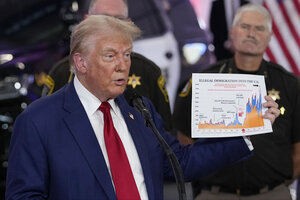What is Project 2025? Inside the wish list Trump disavows.
Loading...
| Washington
For months, Democrats have been mentioning a certain Republican presidential transition plan at every opportunity. GOP leaders have consistently tried to change the subject.
Published by the Heritage Foundation, the document in question – Project 2025 – sets out plans to prepare for “the next Conservative Administration.” In an election year that’s focused more on personality than on policy, the blueprint has become a magnet for critics who see it as symbolizing the dangers of a Republican administration. Meanwhile, former President Donald Trump says he “knows nothing” about the project.
Dense policy papers don’t usually become news items, and Project 2025 is just the latest version of the conservative think tank’s “Mandate for Leadership” report, which they’ve updated and released nearly every four years for decades. Nonetheless, 57% of Americans now view Project 2025 negatively, including 85% of Democrats and 33% of Republicans, according to a September poll by NBC News.
Why We Wrote This
Project 2025, a policy planning effort by a conservative think tank, has captured much attention on the presidential campaign trail and in the media. We help decode what’s in it.
What is Project 2025?
The sweeping policy road map is intended to guide the next Republican administration. It was developed in 2022 by Heritage staff, as well as nearly 300 contributors, and has four parts:
- The 922-page “Mandate for Leadership 2025: The Conservative Promise,” a compilation of essays outlining a conservative policy agenda.
- A personnel database that’s been assembled to share with a conservative president-elect.
- Videos training conservatives on how to serve in a presidential administration.
- Transition plans for the first 180 days for each federal agency.
Some of the items are long-standing conservative goals, such as simplifying the tax code and countering China. Others reflect changes in the party agenda brought by Mr. Trump. And much of the document echoes Mr. Trump’s rhetoric on topics like border security and LGBTQ+ rights.
Mr. Trump has publicly distanced himself from the project, saying he has no interest in even reading it. But its authors include many former officials from his administration. The original director of the project, Paul Dans, served as the chief of staff for the U.S. Office of Personnel Management under Mr. Trump. Another author, Russell Vought, ran the Office of Management and Budget – and was policy director of this year’s GOP platform committee.
During Mr. Trump’s first year in office, his administration implemented 64% of the policy recommendations from the 2016 Heritage “Mandate for Leadership” report, according to the think tank’s own tally. If elected again, Mr. Trump could seek to implement any of the policies laid out in Project 2025, though some of its more aggressive agenda items would almost certainly be challenged in court.
What does Project 2025 say about abortion?
The authors lay out a plan to significantly curtail abortion access, including by further restricting the use of federal funds for abortion care and limiting access to mifepristone, a commonly used abortion medication. The document recommends the FDA rescind its approval of the drug, which would remove it from the market.
At the Oct. 1 vice presidential debate, Minnesota Gov. Tim Walz warned that under Project 2025, Republicans would create “a registry of pregnancies.” But there’s no mention in Project 2025 of tracking the identities of women who’ve obtained abortions. Rather, the plan proposes that it be mandatory for states to report the numbers and details of abortion procedures to the Centers for Disease Control and Prevention.
Vice President Kamala Harris has frequently said that “In [Mr. Trump’s] Project 2025 there would be a national abortion ban.” While the plan does not explicitly call for such a ban, it does say the next conservative administration should work to “protect the unborn in every jurisdiction in America.” Passing a national ban on abortion would ultimately depend on the makeup of Congress.
What does Project 2025 say about the Department of Justice?
Project 2025 holds that the Department of Justice has “lost its way in recent years and forfeited the trust of large segments of the American people.”
In the aftermath of Watergate and President Richard Nixon’s resignation, the Department of Justice implemented reforms to cement its independence and limit White House interference with law enforcement decisions.
Under Project 2025’s plan for the Justice Department, those barriers would be diminished and the DOJ would answer more directly to the White House. Since the end of his term Mr. Trump has claimed repeatedly that his legal troubles – prosecutions for falsification of business records, election interference, and mishandling of classified documents – are politically motivated.
The plan calls for the DOJ to abandon calls for criminal justice reform and take legal action against district attorneys who don’t prosecute cases, especially relating to immigration infractions. It also says the DOJ should enforce the death penalty in more cases and overhaul its civil rights division.
The document pays particular attention to the FBI. It suggests moving the FBI under a “politically accountable” leader. Other proposals include banning the agency from combating misinformation and disinformation by Americans unless they’re tied to “plausible criminal activity.”
What changes are proposed for the federal civil service?
A major goal throughout Project 2025 is the dismantling of the “Administrative State,” the document’s term for the policy work performed by federal agency bureaucrats, rather than by Congress.
Project 2025 proposes reimplementing Schedule F, an executive order issued by Mr. Trump and repealed by President Joe Biden, which would remove civil service protections from an estimated 50,000 civil servants whom the president could then fire at-will. Project 2025 also includes a database of “properly vetted” conservative personnel to staff the next administration.
Critics warn that it would usher in a return to the spoils system of the 19th century and the corruption that accompanied it. The report’s authors counter that the current system shields bureaucrats from accountability.
Logistically, it’s unclear whether any administration could successfully process tens of thousands of new appointments when presidents often struggle to fill even 4,000 positions.
What does Project 2025 say about education and social issues?
Principally, the authors lay out a plan for dismantling the federal Department of Education, a conservative goal ever since President Jimmy Carter created the department in 1979. Federal functions that are not absorbed by other departments would be eliminated, including free school meals and programs providing funding for low-income young children.
All education-related decisions should be returned to the state and local level, the document says, and school choice should be more widely established. Many of its proposals reference “gender ideology,” including a mandate that students in public schools be addressed only by the name on their birth certificate, unless parents or guardians provide written permission otherwise. It says classroom materials should be posted online to provide transparency to parents.
The report takes aim at pornography, saying it propagates “transgender ideology,” and suggests making it illegal and jailing anyone who distributes it. The authors suggest that any educator who teaches books that fall under their broad definition of “pornographic” be registered as a sex offender, a threat that critics say acts as a de facto book ban.
Early in the document, the authors pledge to delete references in federal rules and grants to terms such as sexual orientation; gender identity; diversity, equity, and inclusion; gender; gender equality; abortion; reproductive health; and reproductive rights.
Editor’s note: The spelling of Russell Vought’s name was corrected Oct. 4, 2024, the date of the article’s initial publication.


















